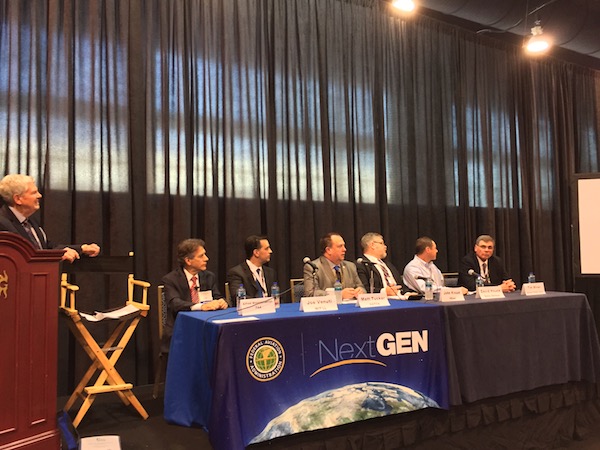
Oct. 21, 2016 // ATCA 2016 Panel: NextGen Weather Systems User Forum
Moderator:
Ernie Dash, FAA
Panelists:
Matt Tucker, NATCA
Alfred Moosakhanian, FAA
John Kosak, NBAA
Joseph Venuti, MIT Lincoln Labs
David Houck, Delta Air Lines
Tim Miner, Allied Pilots Association
Overview:
Decision makers in the National Airspace System (NAS) require a clear, consistent presentation of weather information to ensure safety and efficiency for air traffic operations. The panel focused on the challenges within the current weather environment, where multiple weather displays from the Weather and Radar Processor (WARP), the Integrated Terminal Weather System (ITWS), and the Corridor Integrated Weather System (CIWS) all depict different information.
NextGen Weather is designed to transform and consolidate weather information and seeks to provide tailored aviation weather products within the NAS. By consolidating information, controllers and operators will be able to develop more reliable flight plans, make better decisions, and improve on-time performance.
While some weather products are effectively integrated with operational decision support tools, users still require a stand-alone dedicated weather display. Part of the NextGen Weather Processor (NWP) — the Aviation Weather Display (AWD) — consolidates today’s WARP, ITWS and CIWS displays. The AWD provides consistent weather information “at a glance” for en route and terminal controllers.
The continued integration of new programs into facilities and into the cockpit is a primary goal of all stakeholders because it will improve how all users operate within the NAS.
 |
| From left to right: Dash, Moosakhanian, Venuti, Tucker, Kosak, Houck, and Miner. |
“Right now, we’re 25 seconds behind on weather,” explained Tucker. “What’s coming through NextGen will give us weather updates in real time. I’m excited with where we’re going. It took 15 years to get to this point and in the next five years, we will jump leaps and bounds over what we currently have.”
In addition to real-time decision-making, a major advantage of consolidating and integrating new weather technology is the ability for the pilot and controller to look at the same information. This will facilitate better decisions about where an aircraft should be during weather events.
Miner explained that as a pilot, he makes tactical instead of strategic decisions while in the air. His primary goal as a pilot is ensuring he has enough fuel to avoid potential hazards and still get to his desired destination. He said that he relies on air traffic controllers on the ground to make the best strategic decisions for flight paths.
“Right now, air traffic controllers are looking at one weather picture and pilots are looking at a different weather picture,” added Tucker. “As updates go into place, we will have the same data set to work from, which will enable better communication between the controller and pilot.”
All panelists agreed that having the same data set to work from would be preferable. Kosak elaborated, saying users need to be able to look at a weather product and understand why certain decisions about where to route traffic are happening. He said that if everyone were on the same page, then there would be better communication and compliance within traffic management initiatives.
Miner added that in addition to those benefits, working from the same data set would improve safety.
“Safety must not be a competitive field,” said Miner. “Safety must be a universal system.”
Tucker agreed, saying that collaboration is key to the safe implementation of any new technology into the NAS.

